Mutton and lamb
- Details
 Mutton and lamb exhibit the highest content of L-carnitine among all kinds of meat (up to 210 milligrams per 100 grams of product). L-carnitine is an essential element of fat decomposition process. It transports free fatty acids to mitochondria for oxidization. This process provides plenty of energy which significantly increases the endurance of the organism. L-carnitine is also an important element of preventing cardiovascular diseases and cardiac disorders. When it comes to pork and poultry, they exhibit the lowest content of L-carnitine – 32.5 milligrams per 100 grams and 7.5 milligrams per 100 grams, respectively.
Mutton and lamb exhibit the highest content of L-carnitine among all kinds of meat (up to 210 milligrams per 100 grams of product). L-carnitine is an essential element of fat decomposition process. It transports free fatty acids to mitochondria for oxidization. This process provides plenty of energy which significantly increases the endurance of the organism. L-carnitine is also an important element of preventing cardiovascular diseases and cardiac disorders. When it comes to pork and poultry, they exhibit the lowest content of L-carnitine – 32.5 milligrams per 100 grams and 7.5 milligrams per 100 grams, respectively.
Mutton and lamb also exhibit the most beneficial ratio of omega-6 to omega-3 fatty acids among all kinds of meat obtained from terrestrial livestock, which is 3.53:1 (in the case of sheep fed exclusively with grass the ratio is 1.35:1). The most beneficial ratio of omega-6 to omega-3 fatty acids in everyday diet is 5-6:1. What is worth noting, scientific research suggests that high omega-6 fatty acids intake with simultaneous omega-3 fatty acids deficiency may lead to several inflammatory and degenerative diseases. The poorest ratio of omega-6 to omega-3 fatty acids is characteristic of pork and poultry, 23.8:1 and 13.8:1, respectively.


